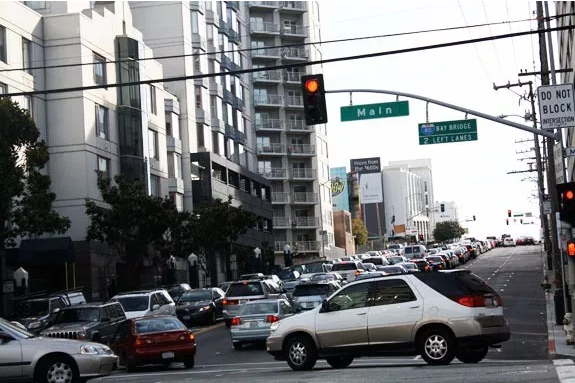Note: GJEL Accident Attorneys regularly sponsors coverage on Streetsblog San Francisco and Streetsblog California. Unless noted in the story, GJEL Accident Attorneys is not consulted for the content or editorial direction of the sponsored content.
After years of failed efforts, New York City finally got the legal clearances to move ahead with congestion pricing. So where does that leave San Francisco?
"Its time is near," said TransForm's Edie Irons. Just as in New York, San Francisco's traffic has grown increasingly intolerable in the past few years, she explained, and "in New York people actually came together around this solution."
The idea, of course, is to charge motorists for entering the most congested parts of the city during periods of highest traffic. The funds raised from that charge would go to transit improvements, so more people would have an alternative to driving. Congestion pricing has proved its worth in cities overseas, such as London and Stockholm, where traffic flow improved significantly. However, New York will be the first city to try it in North America.
San Francisco has toyed with the idea for some time. The San Francisco County Transportation Authority (CTA) recently approved funding for additional studies on how to apply it locally. And last year, legislation was authored by Senator Scott Wiener and Santa Monica Assemblyman Richard Bloom that would have given San Francisco the state clearances it needs. It died in committee, but last week Wiener told San Francisco's CBS affiliate that he could potentially bring it back next year if the city is ready to try a pilot project. “We already have a form of congestion pricing," he said. "If you cross the Bay Bridge during rush hour, it’s higher toll. That’s congestion pricing."
Last November, SPUR's Sarah Jo Szambelan defined principles for implementing congestion pricing successfully. Congestion pricing, according to the report, is part of as set of strategies to "discourage driving by asking drivers to pay a share of the costs it imposes on others." It's similar to a gas tax, except that it targets a specific areas to help mitigate traffic delays and pollution from idling cars where it's at its worst.
TransForm's report on congestion pricing stresses that, if done right, it can also advance equity. "There have to be protections in place and it has to be thoughtfully structured to spend the revenue on affordability and access, especially for the most vulnerable people," said Irons, adding that any plan has to "protect the most vulnerable people from undue harm because there are costs."
How much those costs will be, and exactly how discounts would be structured, is still being determined. But an idea of what it could look like can be seen in a November 2018 presentation from the CTA. It recommends, among other things, a $3 charge to drive into the congestion zone during peak times, with a $6 cap so that businesses making deliveries don't have to pay over and over again. It would also have discounts for zone residents and disabled drivers.
Irons told Streetsblog it's essential that the proceeds from the program go to building out and improving the transit system, so it does what it's supposed to do--give people a viable alternative to driving. "It has incredible potential to actually advance equity and make transit much better and more affordable and that's what they're going to do in New York." She added that without congestion pricing, it's inevitable that transit fares will go up to fund transit improvements (or service frequencies will go down), which just pushes people to drive more.
"New York has been much bolder than San Francisco in reclaiming road space to improving walking, cycling, and public transit," wrote Livable City's Tom Radulovich, in an email to Streetsblog. "The congestion charge will complement that."
According to an official at the CTA, outreach for a pilot could begin as early as this summer. Assuming legislative approval for the pilot in Sacramento, it would be until at least 2021 before San Francisco could join Singapore, London, Stockholm, Singapore, Milan, Gothenburg, and New York in charging a fee to drive in the most congested parts of the city.
Where do you stand on congestion pricing? Do you think it can clear up traffic and make San Francisco's streets safer and less polluted?
Post your thoughts below.






